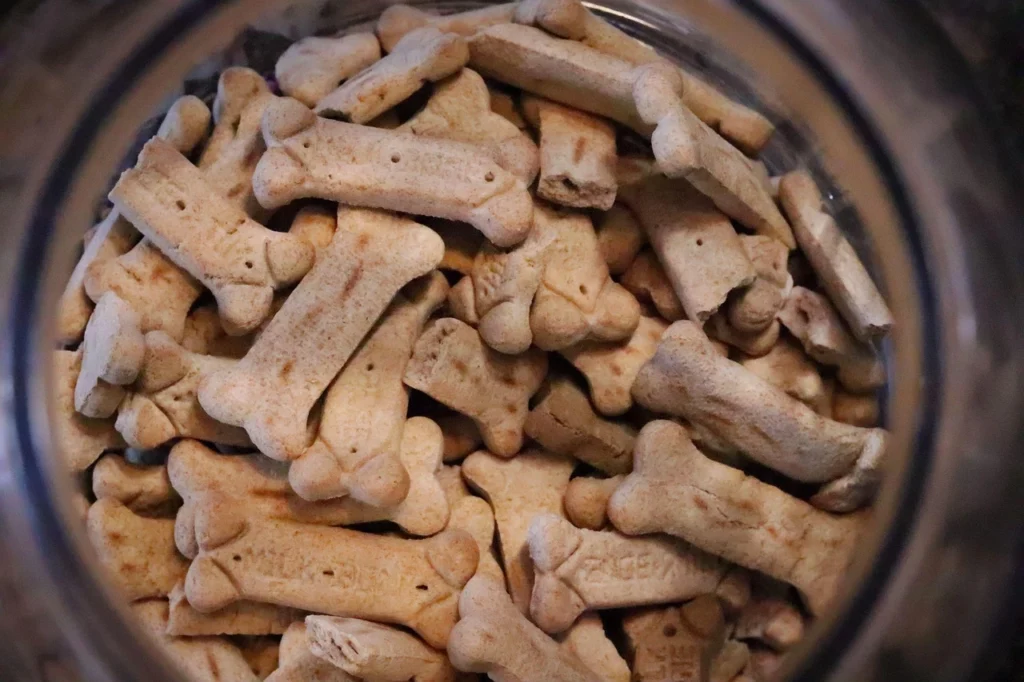Are Milk Bones Bad For Dogs?

You love your furry friend. When those big eyes stare up at you, it’s hard not to reach for a crunchy snack to reward their loyalty. But lately, you’ve wondered: is this treat as wholesome as it seems? Many pet parents share your hesitation, especially when labels list unfamiliar additives or wheat fillers.
Milk-Bone® products have been a go-to for decades, often used during training or just to show affection. However, their ingredient list includes preservatives like BHA, which some studies link to long-term health concerns. While occasional use may not harm your pup, daily reliance could add up over time.
This article breaks down what’s inside these snacks, examines how moderation matters, and explores healthier alternatives. We’ll reference veterinary insights and product analyses to help you make informed choices. After all, every treat should support your companion’s well-being—not just their temporary joy.
Understanding Milk Bones and Their Ingredients
Many crunchy snacks lining store shelves promise benefits for pets, but their formulas often raise questions. To make informed choices, it’s essential to decode what goes into these popular products. Let’s peel back the label to see what’s really inside.
Breakdown of Common Ingredients
Milk-Bones® rely heavily on grains like wheat as a base, mixed with meat by-products for flavor. These by-products may include organs or tissues not typically consumed by humans. Manufacturers also add vitamins and minerals to position them as a supplemental treat.
While some ingredients sound straightforward, others hide behind vague terms. For example, “natural flavors” could mean anything from chicken broth to undisclosed additives. This ambiguity makes it tough for owners to assess quality.
Nutritional Value and Hidden Additives
Beyond basic components, these snacks often include preservatives like BHA to extend shelf life. Though approved for use, studies suggest potential risks with prolonged exposure. Sugars and artificial colors also appear in some varieties, adding empty calories.
The market offers countless options, but not all prioritize transparency. Industry standards allow certain fillers that dilute nutritional value. Always compare labels—simpler lists usually mean fewer hidden compromises.
Balancing dental benefits against questionable additives requires careful thought. Your companion’s long-term health deserves more than temporary crunch appeal.
Health Implications: Are Milk Bones Bad for Dogs?
Crunchy snacks might seem harmless at first glance, but their hidden components can influence your pet’s well-being over time. While occasional nibbles rarely cause alarm, daily exposure to certain additives could lead to bigger concerns. Let’s explore how specific ingredients affect your companion’s vitality.
Potential Long-Term Health Risks
Butylated hydroxyanisole (BHA), a common preservative in many snacks, has sparked debates. Studies suggest prolonged intake might increase cancer risks in animals. Though approved for use, organizations like the National Institutes of Health recommend minimizing exposure.
Wheat flour, another staple ingredient, often triggers allergies or digestive discomfort in sensitive pets. Chronic inflammation from such reactions can weaken their immune response. Over months or years, these subtle effects may escalate into serious conditions.
Immediate Effects Versus Cumulative Impact
Short-term issues like mild stomach upset or skin irritation might resolve quickly. However, frequent consumption of calorie-dense snacks contributes to weight gain. Obesity raises the likelihood of joint pain, diabetes, and heart strain.
Consider this: feeding just two extra treats daily could add 10% to your pet’s caloric intake. Over weeks, this imbalance disrupts their nutritional equilibrium. Combine that with additives like artificial colors, and the risks compound silently.
Veterinary nutritionists emphasize moderation. As one expert notes, “Treats should never exceed 10% of a dog’s diet—quality matters as much as quantity.” Prioritize simpler recipes with recognizable ingredients to safeguard their long-term health.
Exploring Natural Alternatives for Dog Treats

Rewarding your pet doesn’t require compromising their health—plenty of wholesome options exist beyond conventional snacks. Fresh ingredients and transparent recipes can deliver both nutrition and tail-wagging excitement. Let’s uncover choices that prioritize vitality over empty calories.
Fresh Fruits and Vegetables as Treats
Crunchy carrot sticks or crisp apple slices offer vitamins and fiber without artificial additives. Many pets love blueberries, which pack antioxidants, or frozen green beans for low-calorie chewing. Always remove seeds and avoid toxic foods like grapes or onions.
These whole-food alternatives often contain fewer fillers than processed biscuits. They’re ideal for training sessions since small portions maintain calorie control. Plus, their natural flavors keep pups engaged without relying on synthetic enhancers.
Homemade and Premium Commercial Options
Creating treats at home lets you skip unnecessary sugar and preservatives. Simple recipes using pumpkin, oats, or lean meats take minutes to bake. For busy owners, brands like The Honest Kitchen® use air-dried meats with minimal processing.
Premium products typically avoid wheat fillers and BHA, focusing instead on digestible proteins. Compare labels: shorter ingredient lists usually mean cleaner nutrition. As one veterinary nutritionist notes, “Every snack should contribute to their overall diet—not just fill their belly.”
Whether homemade or store-bought, prioritizing freshness ensures your companion gets the best. Always research brands and rotate flavors to keep meals exciting and balanced.
Tips for Choosing Quality Dog Treats
Navigating the pet snack aisle can feel overwhelming with endless options claiming health benefits. Focus on three pillars: label literacy, professional guidance, and dietary balance. Smart choices start with knowing what to prioritize—and what to avoid.
How to Read Ingredient Labels Effectively
Flip the package and scan the first five ingredients—these make up most of the product. Avoid items listing vague terms like “meat meal” or excessive flour. Fillers such as corn syrup or cellulose add bulk but lack nutritional value.
Watch for red flags:
- Artificial preservatives (BHA/BHT) linked to long-term health issues
- Sugar alcohols or unnamed “flavors”
- Multiple starch sources crowding out protein
High-quality products feature recognizable components like sweet potatoes or chicken liver. Look for added minerals like calcium for dental benefits.
Consulting with Your Veterinarian
Schedule a chat about your companion’s specific needs. Vets spot allergy triggers like wheat or soy that generic labels might miss. They’ll also recommend brands avoiding ingredients tied to cancer risks in sensitive breeds.
Ask about calorie limits based on age and activity level. Puppies and seniors often require different nutritional content in treats.
Balancing Treats with a Nutritious Diet
Limit snacks to 10% of daily calories—roughly one small biscuit per 10 pounds. Pair treats with meals rich in lean proteins and fiber to maintain energy levels. Rotate flavors weekly to diversify nutrient intake without overloading on any single ingredient.
Remember: A treat’s purpose isn’t just indulgence. It should complement your pet’s overall wellness strategy.
Related post: Is Beef Hide Bad for Dogs?
Conclusion
Choosing the right snacks for your pup requires balancing taste with nutritional quality. While occasional treats like Milk-Bones® pose minimal risk, frequent use introduces preservatives and excess calories that may impact long-term health. Always prioritize products with simple, recognizable ingredients to avoid hidden additives.
Moderation remains key—limit daily intake to prevent weight gain or nutrient imbalances. Pair snacks with vet-approved meal plans tailored to your dog’s needs. Checking labels helps spot unnecessary fillers or artificial flavors that offer little benefit.
Switching to ground meat treats or carrot sticks reduces preservative exposure while keeping calories in check. High-quality options can even combat tartar buildup, promoting healthier teeth.
Your choices directly shape your companion’s vitality. By focusing on transparency and smarter intake, you’ll turn every treat into a step toward their well-being.
FAQ
What ingredients in Milk Bones® could harm my dog?
Some formulas contain additives like butylated hydroxyanisole (BHA), a preservative linked to potential health risks. Wheat flour and sugar are also common, which may contribute to weight gain or allergies in sensitive pets. Always check labels for artificial colors or fillers like meat by-products.
Can these treats cause long-term health issues?
Frequent consumption of low-quality snacks might lead to obesity, dental problems, or digestive discomfort over time. Ingredients like excess carbohydrates or synthetic preservatives could strain your pet’s system, especially if fed as a primary reward instead of occasional indulgences.
Are there safer alternatives to commercial biscuits?
Yes! Fresh veggies like carrots or green beans offer crunch without empty calories. Brands like Zuke’s or Blue Buffalo provide limited-ingredient options with real meat as the first component. Homemade treats using pumpkin or peanut butter (xylitol-free) are also popular choices.
How do I identify high-quality treats?
Prioritize products with named protein sources (e.g., chicken, salmon) at the top of the ingredient list. Avoid vague terms like “animal fat” or “meal.” Look for certifications from AAFCO or vet-recommended brands, and ensure treats make up ≤10% of your dog’s daily caloric intake.
Should I consult my vet before changing my dog’s treats?
Absolutely. Veterinarians can recommend options tailored to your pet’s age, breed, or health conditions. They might suggest dental chews for tartar control or hypoallergenic snacks if your dog has sensitivities. Regular check-ups help monitor how dietary choices impact overall wellness.




